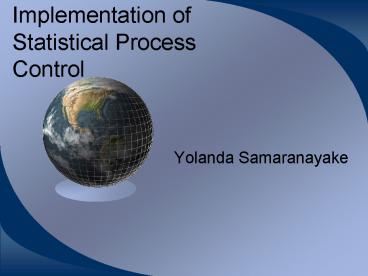Implementation of Statistical Process Control - PowerPoint PPT Presentation
1 / 26
Title:
Implementation of Statistical Process Control
Description:
Control charts are a proven technique for improving productivity. ... Skewness and Kurtosis. Transformations of Non Normal Measurements. Example of Non Normal Data ... – PowerPoint PPT presentation
Number of Views:153
Avg rating:3.0/5.0
Title: Implementation of Statistical Process Control
1
Implementation of Statistical Process Control
- Yolanda Samaranayake
2
Usefulness of Control Charts
- Control charts are a proven technique for
improving productivity. - Control charts are effective in defect
prevention. - Control charts prevent unnecessary process
adjustments. - Control charts provide information about process
capability.
3
Types of Control Charts
Individual Control Chart
Where d2 1.128 for a moving range of 2.
4
Exponentially Weighted Moving Average Chart (EWMA)
5
Outliers in the Measurements
(Quantile Box Plot and Outlier Box Plot)
6
Distribution of the Measurements
Data from a normal distribution
7
Data from a non-normal distribution
8
Data from a bi-modal distribution
9
Tests of Normality
- Shapiro-Wilk W Test
- Normal Quantile Plot
- Skewness and Kurtosis
10
Transformations of Non Normal Measurements
11
Example of Non Normal Data
12
(No Transcript)
13
Distribution of log (X)
14
Process Capability
15
Rules for Out of Control
- Point outside the control limit of the individual
control chart - Point outside the EWMA
16
Standardized Measurements for Batch Processes
- Approach 1Use when the standard deviations of
the different products are similar (approximately
10). - Approach 2Use when the standard deviations of
the different products vary by more than 10. - Approach 3Use when the standard deviation is
proportional to the process average
X actual measurement - TA where TA is some
target value
X ((actual measurement TA)/TA)100
17
Calculation of Control Limits
- Determine number of measurements needed to
calculate control limits (at least 30) - When number of measurements is less than 30,
limits can be based on some historical data - Fixing limits after knowing a stable process
- Check limits at regular intervals to determine if
a re-calculation is necessary (i.e. a change in
the mean or standard deviation due to raw
materials)
18
Examples
Non-Normal Data
19
Distributions Particles
Normal(11.6815,9.92325)
20
Distributions Particles
Normal(9.516,6.2067)
21
Log Particles
Normal(2.01563,0.74043)
22
CPK 3.03 USl 60
CPK 1.02 UCL 57.4 Xbar 7.5 LCL .98
23
Examples
Bi-Modal Distribution
24
Distributions Iron
Normal(0.05784,0.02222)
25
Population 1
Population 2
Normal(0.08395,0.00828)
Normal(0.03711,0.00511)
26
Population 1
Population 2































